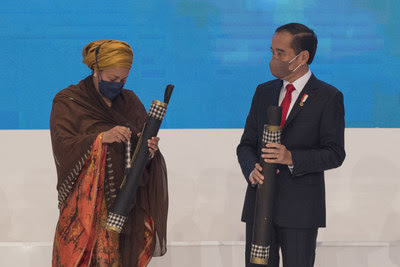Some African countries with elephant populations say they want to lift an international ban on ivory trading and culling elephant herds. Representatives meeting in Zimbabwe ahead of the Convention on International Trade in Endangered Species later this year say elephant overpopulation is harming communities and vegetation.
Fourteen African countries say they want communities with elephant populations to benefit from them. As a result, they issued a communique Thursday after a four-day conference asking for a ban to be lifted on ivory trading and elephant culling.
The group plans to take that message to Panama in November for the Convention on International Trade in Endangered Species or CITES, an agreement among governments to ensure that wild animal and plant species are protected.
Nqobizitha Mangaliso Ndlovu is Zimbabwe‘s wildlife minister.
“Mainly to say as African states we hold the significant population of our elephants. It is therefore important that the ideas, the proposals that we are proffering at CITES need be taken seriously, key among them issues of our wildlife products. We are currently spending a lot of money taking custody of our ivory, which ivory we are restricted from trading. We want to believe that this is one of the key outcomes that we are anticipating to come from CITES that we can be allowed to plow back into conservation wildlife products,” said Ndlovu.
Zimbabwe says its national parks are home to nearly 100,000 elephants, double the number parks can comfortably accommodate.
Government officials say as a result, the animals are moving out of the parks and destroying local crops.
Sithembiso Mampofu Sibanda is a 59-year-old Zimbabwean widow living just outside Hwange National Park.
She said the elephants are bothering locals and invading their fields and homes, and that locals can no longer farm their fields. Farmers are asking authorities, she said, to build a fence to keep elephants out.
Some African countries, such as South Africa, which is home to 45,000 elephants, oppose lifting the ban. Officials there say South Africa uses birth control to manage the elephant population and fences on national park boundaries.
Sam Ferreira is a Large Mammals Ecologist at South Africa National Parks.
“One of the difficulties is people trying to think that the African manager of wildlife has got only one solution, in fact they don’t, they go through some very serious thinking about what can l do before they get to the really hard difficult ones, now l have to permanently remove an animal,” said Ferreira.
The European Union opposes lifting the ban on elephant ivory trading and questions the data Zimbabwe used to estimate of its elephant population.
Timo Olkkonen, the European Union Ambassador to Zimbabwe, said, “l think you know my understanding is that there is information required about carrying capacities and so forth. So, l think there is probably work to be done.”
Zimbabwe accuses the European Union and other Western countries of influencing CITES to keep the ban on trading ivory, which was implemented to protect dwindling numbers of elephant species from poachers on the continent.
The ban has encouraged the growth of elephant populations but is also causing problems for people like Sibanda.
Source: Voice of America

